|
Predators
Sharks
What do you think of first when you think of sharks? Fearsome,
big teeth, and unprovoked attacks on swimmers. Sharks, however,
have many other interesting features that make them stand
out from other denizens of the sea. The main difference from
other fishes is that their skeleton is made from cartilage
rather than bone. This cartilage makes sharks very flexible,
allowing them to twist 360 degrees and whirl around and bite
an unsuspecting diver or fisherman.
Sharks don't have an air bladder, and if they stop swimming
they will sink. To overcome this disadvantage, they have very
large, oil-filled livers giving them some buoyancy. An advantage
of not having a swim bladder is that it gives sharks great
vertical mobility allowing them to rapidly move upward in
the water column without the development of bends. In addition,
their pectoral fins act as glide-planes and provide great
lift as the shark swims.
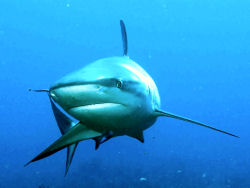 Sharks
have many other interesting characteristics. Shark meat has
an unpleasant taste due to the presence of high concentrations
of the waste product urea in the tissue. Sharks store urea
to maintain an osmotic balance with seawater so as not to
have a water loss problem. Sharks
have many other interesting characteristics. Shark meat has
an unpleasant taste due to the presence of high concentrations
of the waste product urea in the tissue. Sharks store urea
to maintain an osmotic balance with seawater so as not to
have a water loss problem.
Shark reproduction is very different from that of most bony
fishes, having a very low output from their internal fertilization
and production of large young. Sharks also have very low growth
rates, a problem that is compounded by overfishing.
An interesting sense that sharks possess is one called electroreception.
There is a system of jelly-filled pores around the head and
mouth called "ampullae of Lorenzini" that can detect
small electric fields of less than 0.01 microvolt. This has
been used to develop a small shark repelling apparatus for
divers to wear that seems to be effective in warding off sharks.
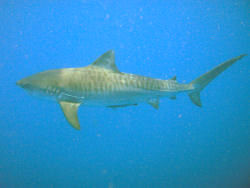 Sharks
can see colour, as indicated by the presence of cone cells
in their retinas. Similar to cats, they have a light-reflecting
layer to enhance their night vision. This is important to
divers to realize that swimming and diving in shark infested
waters at night is more dangerous. The reason that chumming
works so well in attracting sharks is their acute sense of
smell. This could be a warning not to dive with even the smallest
cut or abrasion. The most economically important sharks are
the sandbar, bull, and lemon which do not mature until about
12 to 18 years of age. Slow growth is the norm; for example,
a tagged immature male sandbar shark was recaptured 15 years
later and had only grown about 19 inches and was still immature. Sharks
can see colour, as indicated by the presence of cone cells
in their retinas. Similar to cats, they have a light-reflecting
layer to enhance their night vision. This is important to
divers to realize that swimming and diving in shark infested
waters at night is more dangerous. The reason that chumming
works so well in attracting sharks is their acute sense of
smell. This could be a warning not to dive with even the smallest
cut or abrasion. The most economically important sharks are
the sandbar, bull, and lemon which do not mature until about
12 to 18 years of age. Slow growth is the norm; for example,
a tagged immature male sandbar shark was recaptured 15 years
later and had only grown about 19 inches and was still immature.
Sharks do not attack humans for the sole purpose of hunger.
In fact, sharks do not know what the feeling of hunger is,
and in fact, can go for many months without eating. This is
not to say that sharks do not attack with the intention of
seeking prey. Many attacks on divers and surfers especially
can be attained to searching for food. To a shark, a surfer
on a surfboard slightly resembles that of a seal or sea lion,
or a diver in a black wetsuit can look like other prey.
 Sharks
also attack humans because they have been provoked or agitated
by the person. Many spear-fishers have been attacked by reef
sharks because when they spear fish, the blood from the fish
and it's vibrations can sometimes result in a feeding frenzy
by many sharks. Sharks
also attack humans because they have been provoked or agitated
by the person. Many spear-fishers have been attacked by reef
sharks because when they spear fish, the blood from the fish
and it's vibrations can sometimes result in a feeding frenzy
by many sharks.
Bright colours can also be counted for attacks. As many people
have believed in the past, sharks do in fact can see colours,
and do indeed have very good eyesight. Avoid wearing the colours
of orange and yellow, as this can aggravate the shark, and
possibly lead to attacks.
Sharks are in fact attracted by splashing and vibrations in
the water, and it can sometimes be attributed to attacks.
Most scientists have not been able to predict why and where
sharks attacks.
The following is a list of preventative measures you, as a
swimmer or diver can do to prevent the possibility of shark
attacks:
- Do
not tease or entice sharks!
 If
you cut or injure yourself... get out! Do not stay in the
water with blood around you. Sharks can smell blood from
over a mile away. And, for the women who read this, if you
are in the middle of your menstrual period, please stay
out of the water for your own sake. If
you cut or injure yourself... get out! Do not stay in the
water with blood around you. Sharks can smell blood from
over a mile away. And, for the women who read this, if you
are in the middle of your menstrual period, please stay
out of the water for your own sake.
- Watch
other fish and turtles in the area--if they start acting
erratic--be alert that a shark might be in the area.
- Do
not swim in waters that have been deemed dangerous. Avoid
swimming in murky waters. If you feel something brush up
against you.... get out of the water to check to make sure
that you have not been bitten. Many shark attack victims
have noted the lack of pain from being bitten, doctors and
scientists have not been able to conclude why this occurs..
so if you have been brushed against by something, get out
and investigate. Finally, if you don't feel right in the
water. Then get out! Nothing can be said for "gut feeling."
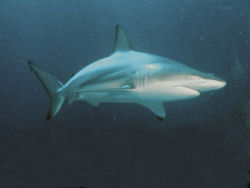 Fortunately
most shark attacks are not fatal, however, there are a percentage
of attacks that are fatal. There are only four species of
sharks who consistently attack people: The Great White, The
Tiger, The Bull, and The Oceanic White Tip. There are, however,
other large sharks that have attacked humans, and can potentially
dangerous. Fortunately
most shark attacks are not fatal, however, there are a percentage
of attacks that are fatal. There are only four species of
sharks who consistently attack people: The Great White, The
Tiger, The Bull, and The Oceanic White Tip. There are, however,
other large sharks that have attacked humans, and can potentially
dangerous.
When most sharks attack, the first bite is usually a "tester."
Like most people, when sampling food, they bite once, revel
in the taste, and then decide whether or not to continue...
with most sharks, sampling occurs as well. The trouble is,
with the sampling of a Great White or other larger predatory
sharks, the first bite is so massive or severe that many people
die from their injuries, and do not actually die from being
consumed. A lot of fatalities can be attributed to people
bleeding to death or dying from shock.
There are different modes of shark attacks and investigations
that sharks go through when they come across humans. The following
list shows what a shark can do when it comes across a human.
-
Indifference
-
Approach
with swift visual inspection from a distance without follow-up
-
Approach
with surveillance circling - without follow up or contact
and attack
-
Approach
with brush-past, without follow-up (wounding possible)
-
Charge
with collision (upwards trajectory generally)
-
Charge
with single or double investigative bite without tearing
-
Charge
with biting and removal of flesh (death in 45% of cases)
-
Multiple
feeding-frenzy charge (death in 100% of cases)
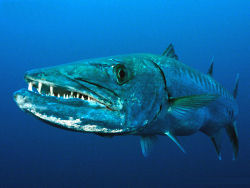 Barracuda Barracuda
The barracuda is any of about 20 species of predatory fishes
of the family Sphyraenidae (order Perciformes). Barracudas
are usually found in warm, tropical regions; some also in
more temperate areas. They are swift and powerful, small scaled,
slender in form, with two well-separated dorsal fins, a jutting
lower jaw, and a large mouth with many sharp large teeth.
Size varies from rather small to as large as 4-6 feet (1.2-1.8
meters) in the great barracuda (Sphyraena barracuda) of the
Atlantic, Caribbean, and the Pacific.
Barracudas are primarily fish eaters of smaller fishes, such
as mullets, anchovies, and grunts. They are good, fighting
sporting fishes, and the smaller ones make good eating. In
certain seas, however, lately increasingly they may become
impregnated with a toxic substance that produces a form of
poisoning known as ciguatera.
Barracudas are bold and inquisitive, and fearsome fishes,
that may be/are dangerous to humans. The great barracuda is
known to have been involved in attacks on swimmers. In Hawai'i,
they have been known to inhabit open waters and bay areas
in the shadows, under floating objects. To avoid them, don't
wear shiny objects. They are attracted to shiny, reflective
things that look like dinner. They cause harm with their sharp
jagged teeth and strong tearing jaws; slashing and creating
jagged tears in your skin. Should you or another be hurt by
one get medical treatment.
Stop any bleeding and treat for shock by keeping yourself
or the victim calm and warm.
Moray Eels
 A
number of divers have been bitten by moray eels, their sharp
teeth designed to lock on to prey sometimes causing severe
damage. These eels are not, by nature, aggressive towards
people but can attack if provoked. Many attacks can be blamed
on the foolish practice of fish feeding by hand. A
number of divers have been bitten by moray eels, their sharp
teeth designed to lock on to prey sometimes causing severe
damage. These eels are not, by nature, aggressive towards
people but can attack if provoked. Many attacks can be blamed
on the foolish practice of fish feeding by hand.
Accustomed to receiving handouts, some approach divers on
sight and can bite a hand which they believe to be holding
food.
For the same reason divers have also been approached aggressively
by potato cod, wrasse, gropers and other fish expecting handouts
of food. While some of these may not inflict injuries there
is the additional threat that novice divers may be frightened
into acting unwisely.
The best prevention is to abide by the GBRMPA fish feeding
guidelines which forbid the hand-feeding of fish.
 Large
Groupers Large
Groupers
The Nassau grouper is common resident in the waters off the
Gulf of Mexico and the Caribbean. Some divers have been "bitten"
by over friendly Nassau groupers that are used to human interaction
in popular dive feeding sites. During feedings groupers occasionally
will take the entire fist and forearm of unsuspecting diver
into their large mouths.
Groupers have several sets of teeth, placed in the mouth to
act as raspers or holding teeth. The fish gulps down its prey
using these raspers to prevent the smaller fish from escaping.
The teeth are not used to tear or slash, as with barracuda
or sharks. One can imagine the problem with this when considering
that some of these fish grow to be as large as 800 pounds.
These bites primarily result in loss of skin from the back
of the hand and fingers, often followed by a severe infection.
Humboldt Squid
 A
mysterious sea creature up to 7 feet long, with 10 arms, a
sharp beak and a ravenous appetite. Packs of fierce Humboldt
Squid reputedly attack nearly everything they see, from fish
to scuba divers. A
mysterious sea creature up to 7 feet long, with 10 arms, a
sharp beak and a ravenous appetite. Packs of fierce Humboldt
Squid reputedly attack nearly everything they see, from fish
to scuba divers.
The Humboldt
squid (Dosidicus gigas), also known as the jumbo squid, jumbo
flying squid, pota or diablo rojo (Spanish for 'Red Devil'),
is a large, predatory squid found in the waters of the Humboldt
Current in the Eastern Pacific Ocean. They are most commonly
found at depths of 200 to 700 metres (660 to 2,300 ft), from
Tierra del Fuego to California.
Recent findings suggest the range of this species is spreading
north into the waters of Oregon, Washington, British Columbia,
and Alaska.
Humboldt
squid are carnivorous marine invertebrates that move in shoals
of up to 1,200 individuals. They swim at speeds of up to 24
kilometres per hour (15 mph/13 kn) propelled by water ejected
through a hyponome (siphon) and by two triangular fins. Their
tentacles bear suckers lined with sharp teeth with which they
grasp prey and drag it towards a large, sharp beak.
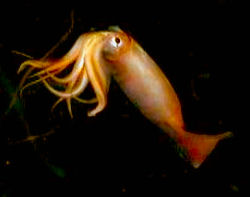 Although
Humboldt squid have a reputation of being aggressive, there
is some disagreement on this subject. Recent research suggests
that Humboldt squid are only aggressive while feeding. At
other times, they are quite passive. Their behavior while
feeding often extends to cannibalism and they have been seen
to readily attack injured or vulnerable squid of their own
shoal. Although
Humboldt squid have a reputation of being aggressive, there
is some disagreement on this subject. Recent research suggests
that Humboldt squid are only aggressive while feeding. At
other times, they are quite passive. Their behavior while
feeding often extends to cannibalism and they have been seen
to readily attack injured or vulnerable squid of their own
shoal.
This behavior may account for a large proportion of their
rapid growth. Some scientists claim the only reports of aggression
towards humans have occurred when reflective diving gear or
flashing lights have been present as a provocation. Roger
Uzun, a veteran scuba diver and amateur underwater videographer
who swam with a swarm of the animals for about 20 minutes,
said they seemed to be more curious than aggressive.
In circumstances where these animals are not feeding or being
hunted, they exhibit curious and intelligent behavior.
Salt Water Crocodile
 This
endangered reptile actually is a danger to underwater enthusiasts
and a number of people are killed and injured each year. It's
hide has a very high commercial value because of its ease
of skinning and because of this it is protected. This
endangered reptile actually is a danger to underwater enthusiasts
and a number of people are killed and injured each year. It's
hide has a very high commercial value because of its ease
of skinning and because of this it is protected.
The saltwater crocodile is the largest living crocodilian
species, growing to 6-7 meters in length and inhabits a very
large area of northern Australia, Indonesia and Malaysia.
Treatment involves management of severe trauma or large predator
injury (similar to head injury, limb injury due to falls,
equipment crush, prop injuries). Call for help and immediate
transport. Maintain open airway, keep face in nuetral position,
be mindful of possible neck injury, direct pressure over bleeding
wounds. Keep warm and treat for shock as needed.
 Contact
Irritants Contact
Irritants
Sea
Anenomes and Sea Cucumbers
While most sea anemones are relatively harmless to humans
a few do contain strong toxic substances producing quite severe
effects. One of these is the stinging anemone (Actinodendron
plumosum), a blue-grey to light brown animal which can look
somewhat like a fir tree.
 Found
under boulders and coral, red bristle worms have numerous
fine needle-like bristles which break off when they have become
embedded in the skin, causing severe irritation. Found
under boulders and coral, red bristle worms have numerous
fine needle-like bristles which break off when they have become
embedded in the skin, causing severe irritation.
Although sea cucumbers are one of the safest animals on the
reef to touch, the numerous white Cuvierian tubules, which
some eject when irritated, contain a toxin which can cause
blindness if it comes into contact with the eyes. This toxin
may also be present on the skin so you should wash your hands
after handling these creatures.
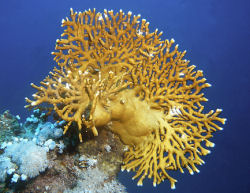 Stinging
Corals Stinging
Corals
Although known widely as stinging or fire corals, these organisms
are, in fact, colonial animals (Millepora sp) more closely
related to hydroids.
Having a hard coral-like skeleton, they vary in form from
large upright sheets and blades to branching, finger-like
'antlers' with a yellow-green to brown colour. Effects and
treatment are similar to hydroid stings.
Hydroids
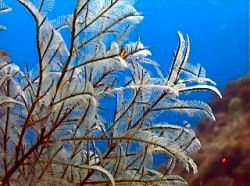 Looking
like feathery plants, and sometimes referred to as fireweed,
hydroids are actually colonies of animals equipped with strong
stinging cells (nematocysts) used to capture prey and for
defence. Looking
like feathery plants, and sometimes referred to as fireweed,
hydroids are actually colonies of animals equipped with strong
stinging cells (nematocysts) used to capture prey and for
defence.
Some species of hydfroid can give quite severe stings causing
inflammation, swelling and pain lasting up to a week. Effects
may sometimes be more severe.
Divers
are particularly prone to brushing against hydroids. Two species
to avoid are this white, fine feathery one and the denser
yellow/brown type. They can be found in fairly shallow reef
areas and on structures such as wharfs.
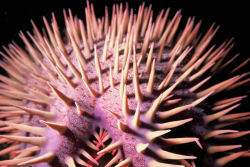
Crown of Thorns Starfish
The sharp spines of this creature are covered with a thin
venomous skin which, if introduced into any wound can cause
nausea, vomiting and swelling. Spines may also break off and
remain embedded.
Box Jellyfish
 Recognized
as one of the greatest marine hazards, box jellyfish (Chironex
fleckeri) kill more people than sharks, crocodiles and stonefish
combined. Recognized
as one of the greatest marine hazards, box jellyfish (Chironex
fleckeri) kill more people than sharks, crocodiles and stonefish
combined.
Each year, in late summer, the adult box jellyfish spawn at
river mouths before dying. The fertilised eggs become tiny
polyps which attach themselves to rocks in estuaries. In spring
these polyps develop into little swimming jellyfish which
migrate down rivers, especially with rains, to feed on shrimp.
Unfortunately, they frequent beaches which humans also find
attractive. The animal does not actively hunt, relying on
food to bump into its tentacles. A struggling shrimp might
tear a delicate jellyfish, so it needs to be killed instantly,
on contact, with a very strong poison.
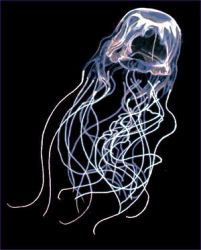 Tentacles,
up to 60 in number and reaching 5m in length, are arranged
in four groups at the corners of a box-shaped bell which can
be as large as a basketball. The tentacles are armed with
up to 5 000 million stinging cells known as nematocysts. These
are triggered into action when stimulated by certain chemicals
found on the surface of fish, shellfish and humans. Contact
with just 3m of tentacles can kill an adult. Tentacles,
up to 60 in number and reaching 5m in length, are arranged
in four groups at the corners of a box-shaped bell which can
be as large as a basketball. The tentacles are armed with
up to 5 000 million stinging cells known as nematocysts. These
are triggered into action when stimulated by certain chemicals
found on the surface of fish, shellfish and humans. Contact
with just 3m of tentacles can kill an adult.
Recent studies have shown that the box jellyfish is able to
see through four eyes, one at the centre of each side of the
bell. How it processes this information without a brain is
still a mystery but the animal is able to avoid even quite
small objects. They probably try to avoid humans in the water,
if given the chance; stings usually occur when people blunder
into them. (They are almost invisible in the water.) It is
certainly in the interest of the jellyfish to avoid turtles
which eat them, apparently unaffected by the stings.
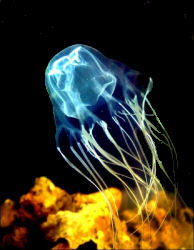 Another
box jellyfish, Chiropsalmus quadrigatus, is generally less
common than Chironex fleckeri, although it may outnumber them
on Cairns to Port Douglas beaches. It is smaller, with slimmer
tentacles, but the two are difficult to tell apart. There
are about 20 species, worldwide, in the Cubozoa, or box jellyfish,
family, Chironex fleckeri is the most lethal member. Another
box jellyfish, Chiropsalmus quadrigatus, is generally less
common than Chironex fleckeri, although it may outnumber them
on Cairns to Port Douglas beaches. It is smaller, with slimmer
tentacles, but the two are difficult to tell apart. There
are about 20 species, worldwide, in the Cubozoa, or box jellyfish,
family, Chironex fleckeri is the most lethal member.
Irukandjis
Although it is more numerous in summer months, the irukandji
(Corukia barnesi) can be found all year round and inhabits
all waters. A member of the box jerllyfish family, it has
one tentacle at each corner of its bell. It is tiny - only
2cm across the bell - but nonetheless packs a massive punch.
Both bell and tentacles have stinging cells.
The actual sting is minor, but 20-30 minutes later the victim
begins to experience agony which lasts for hours. Although
not blamed for deaths its tendency to cause raised blood pressure
can be dangerous for vulnerable victims. Ignoring the initial
sting may also lead to some people suffering severe symptoms
in deep water or while driving later.
 Sea
Urchins Sea
Urchins
It is just common sense to avoid the sharp black spines of
the black sea urchin. They can penetrate deeply into the flesh
and break off causing long-lasting inflammation if not removed
– often surgically. There is doubt as to whether venom
is also involved.
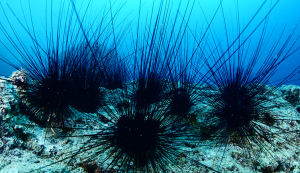 A
less common but much more dangerous urchin is the flower urchin.
Instead of long spines it appears to be covered with numerous
flowers which are in fact little venomous pincers (pedicillariae)
capable of causing paralysis and even death. It has killed
several people in Japan. A
less common but much more dangerous urchin is the flower urchin.
Instead of long spines it appears to be covered with numerous
flowers which are in fact little venomous pincers (pedicillariae)
capable of causing paralysis and even death. It has killed
several people in Japan.
Injected Toxins
Happily for humans, the animals which inhabit the beautiful
cone shells are nocturnal. Hunters by nature, many carry a
toxic concoction which is capable of killing humans; in fact,
the venom from one geographer cone (Conus geographus) is capable
(in theory of course,) of killing 700 people.
There are about 80 species of cone shells in Australia, mostly
in tropical waters. Some feed on worms, some on molluscs (including
other cone shells) and some on fish. It is the last two types
which are most dangerous to humans. To stop a fish in its
tracks a snail needs a formidably fast-acting venom.
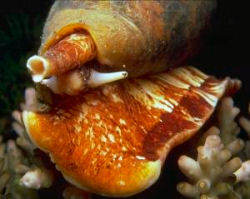 It
is thought that the cone detects its prey from chemicals in
the water drawn through its siphon. Some visual sense may
also be involved. The cone then extends its proboscis, a hollow
feeding tube, on the end of which is a hollow, barbed tooth.
Attached to a poison sac, this tooth is driven harpoon-style
into the hapless victim, poison being injected through the
tooth. The force of the harpoon has been known to penetrate
a periwinkle shell. Each tooth is used only once. A supply
of spares is kept in an internal tooth sac and moved into
position as required. Held by the barbed tooth, the victim
is quickly immobilised by the poison and then drawn into the
expanded proboscis to be digested. A mollusc victim may be
sucked from its shell (certain toxins may loosen its muscular
attachment to the shell, making the task easier). It
is thought that the cone detects its prey from chemicals in
the water drawn through its siphon. Some visual sense may
also be involved. The cone then extends its proboscis, a hollow
feeding tube, on the end of which is a hollow, barbed tooth.
Attached to a poison sac, this tooth is driven harpoon-style
into the hapless victim, poison being injected through the
tooth. The force of the harpoon has been known to penetrate
a periwinkle shell. Each tooth is used only once. A supply
of spares is kept in an internal tooth sac and moved into
position as required. Held by the barbed tooth, the victim
is quickly immobilised by the poison and then drawn into the
expanded proboscis to be digested. A mollusc victim may be
sucked from its shell (certain toxins may loosen its muscular
attachment to the shell, making the task easier).
The best way to avoid stings is not to touch live cone shells.
The extendable harpoon-wielding proboscis is capable of reaching
most parts of the shell so it is not safe to grip the wide
end. Thick shoes should be worn for reef walking and cones
should never be put in pockets or sleeves. Sting symptoms
progress from numbness to breathing failure.
Blue Ringed Octopus
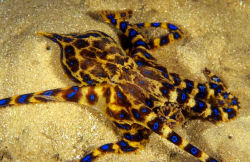 This
potential killer is small, the northern (larger) species reaching
only 20cm across spread tentacles. It is normally yellowish
brown but when disturbed its blue rings become bright and
obvious. It is not aggressive by nature but will bite when
provoked. This
potential killer is small, the northern (larger) species reaching
only 20cm across spread tentacles. It is normally yellowish
brown but when disturbed its blue rings become bright and
obvious. It is not aggressive by nature but will bite when
provoked.
The venom is contained in the saliva, which comes from two
glands each as big as the animal's brain. It has two components.
One is probably most effective on crabs (its main prey) but
relatively harmless to humans while the other, the same as
that present in toad/puffer fish, probably serves as a defence
against predatory fish. Humans, when bitten, usually do not
feel the bite but soon notice a numbness around the mouth
followed quickly by paralysis. Death can result from respiratory
failure.
This octopus lives in shallow water, typically in sheltered
rock pools and crevices, cans and bottles. Never put your
hands where you cannot see them. The venom is not injected
but enters the wound in saliva. Washing the bite may therefore
remove venom from the surface.
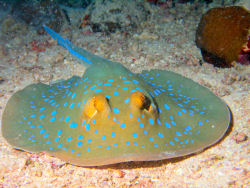 Stingrays Stingrays
Stingrays will defend themselves by lashing out with whip-like
tails equipped with one or two spines. Because they are barbed
they can cause serious gashes and in about two-thirds of species
they are also venomous. The spines are capable of penetrating
wetsuits and shoe leather and have been known to kill people
unlucky enough to have been stabbed in the chest.
Those at risk are people wading, who often get injured on
the leg, careless fishers and divers who may get lashed by
a startled stingray as they swim above it. Prevention involves
shuffling feet when wading. Wash wounds thoroughly with sea
water and remove spines carefully.
Venomous Fish
 A
number of other fish are equipped with similar venomous spines,
although they are more mobile than stonefish and will prefer
to get out of the way. These include members of the scorpionfish
family, such as this popular aquarium fish known by many names
such as lionfish, butterfly cod and firefish. (The freshwater
bullrout is also in this family.) A
number of other fish are equipped with similar venomous spines,
although they are more mobile than stonefish and will prefer
to get out of the way. These include members of the scorpionfish
family, such as this popular aquarium fish known by many names
such as lionfish, butterfly cod and firefish. (The freshwater
bullrout is also in this family.)
Catfish, when interfered with, produce three barbed spines
which stick out at right angles from the back and side fins.
(It is not the whisker-like sense organs around their mouths
which cause the damage.)
Stings from all these fish are painful and can lead to collapse
and even death in exceptional circumstances. The venom in
the spines remains active for days, so discarded spines and
even refrigerated specimens should be treated with caution.
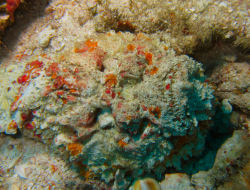 Stonefish Stonefish
The stonefish's lifestyle makes this, the most venomous fish
in the world, particularly dangerous to unwary humans. Lying
on the seabed, looking exactly like an encrusted rock, it
waits for small fish and shrimps to swim by and then, with
lightning speed, opens its mouth and sucks them in. The whole
ambush has been timed at just 0.015 seconds.
Vulnerable to bottom-feeding sharks and rays, it has developed
a defence - a row of unlucky 13 venomous spines along its
back. It is, in fact, the victim who injures him/herself.
Each stonefish spine is encased in a sheath containing bulging
venom glands. Downward pressure on the spine causes the sheath
to be pushed back, the venom from the pressurised glands shooting
forcefully up grooves on the surface of the spine into the
deepest part of the wound. (It takes a few weeks for the glands
to regenerate and recharge.)
Victims become frantic with pain which lasts for hours. Temporary
paralysis, shock and even death may result. Stonefish may
be found from exposed sand and mud in tidal inlets to depths
of 40m. Prevention involves wearing thick-soled shoes and
treading gently - spines may penetrate soles if a stonefish
is jumped on. Also, take care when turning over 'rocks'.
Because of its amazing camouflage it is often overlooked and
seen as just a rock which makes it so dangerous.
Sea Snakes
 Sea
snake venom is more toxic than that of land snakes, however
these animals pose little risk. Most are shy and stay away
from people, biting only when provoked, if at all. Even then
they tend not to use their venom. Sea
snake venom is more toxic than that of land snakes, however
these animals pose little risk. Most are shy and stay away
from people, biting only when provoked, if at all. Even then
they tend not to use their venom.
It is reserved for quickly immobilising prey, not for defence.
In fact, about 65% of bites are 'blanks'. Nevertheless, the
potential danger of a sea snake should not be underestimated
and they should be treated with respect.
Sea snakes are air breathers probably descended from a family
of Australian land snakes. They inhabit the tropical waters
of the Indo-Pacific and are highly venomous. Thirty-two species
have been identified in the waters about the Barrier Reef
in Australia. They seem to congregate in certain areas in
the region about the swain Reefs and the Keppel Islands, where
the olive sea snake (Aipysurus laevis) is a familiar sight.
 Sea
snakes have specialized flattened tails for swimming and have
valves over their nostrils which are closed underwater. They
differ from eels in that they don't have gill slits and have
scales. Due to their need to breathe air, they are usually
found in shallow water where they swim about the bottom feeding
on fish, fish eggs and eels. Sea
snakes have specialized flattened tails for swimming and have
valves over their nostrils which are closed underwater. They
differ from eels in that they don't have gill slits and have
scales. Due to their need to breathe air, they are usually
found in shallow water where they swim about the bottom feeding
on fish, fish eggs and eels.
The yellow-bellied sea snake (Pelamis platurus) is seen on
occasions floating in massive groups. Fish that come up to
shelter under these slicks provide food for the snakes. Occasionally
these yellow-bellies get washed up on beaches after storms
and pose a hazard to children.
Aggressive only during the mating season in the winter, the
sea snake is very curious, and they become fascinated by elongated
objects such as high pressure hoses. Advice here is to inflate
your BC so as to lift away from the bottom and the snake.
Provoked snakes can become very aggressive and persistent
--requiring repeated kicks from the fins to ward them off.
 Persistent
myths about sea snakes include the mistaken idea that they
can't bite very effectively. The truth is that their short
fangs (2.5-4.5mm) are adequate to penetrate the skin, and
they can open their small mouths wide enough to bite a table
top. It is said that even a small snake can bite a man's thigh.
Sea snakes can swallow a fish that is more than twice the
diameter of their neck. Persistent
myths about sea snakes include the mistaken idea that they
can't bite very effectively. The truth is that their short
fangs (2.5-4.5mm) are adequate to penetrate the skin, and
they can open their small mouths wide enough to bite a table
top. It is said that even a small snake can bite a man's thigh.
Sea snakes can swallow a fish that is more than twice the
diameter of their neck.
Most sea snake bites occur on trawlers, when the snakes are
sometimes hauled in with the catch. Only a small proportion
of bites are fatal to man, as the snake can control the amount
of envenomation, a fact probably accounting for the large
number of folk cures said to be 95% effective.
Intense pain is not obvious at the site of the sea snake bite;
30 minutes after the bite there is stiffness, muscle aches
and spasm of the jaw followed by moderate to severe pain in
the affected limb. There follows progressive CNS symptoms
of blurred vision, drowsiness and finally respiratory paralysis.
A specific antivenin is available; if not obtainable-the Australian
tiger snake antivenin or even polyvalent snake antivenin can
be used.
Ingested
Toxins
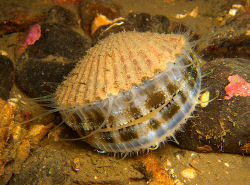 Shell
Fish Shell
Fish
This derives from dinoflagellates contaminating shellfish
(clams, scallops, oysters, etc.). The toxin, saxotoxin, is
water soluble, heat and base stabile, and is therefore not
affected by steaming or cooking. It inhibits sodium channels
of excitable membranes, blocking propagation of nerve and
muscle action potentials.
Symptoms usually occur within 30 minutes, and include parasthesias
of the lips, tongue, gums and face. This process proceeds
to the trunk and may progress to paralysis and respiratory
arrest.
The gastrointestinal form may appear hours or days after ingestion
with nausea, vomiting, diarrhoea and abdominal pain.
There is no specific treatment. Stop eating if oral sensations
are perceived. Empty stomach if systemic symptoms are noted,
using emetic or lavage. Give respiratory support and monitoring
if needed.
Scombroid
 Occurs
in tuna, mackerel, skipjack and other members of the family
scombridae. Fish left at room temperature undergo bacterial
breakdown of tissue histidine to histamine and saurine. Spoiled
fish have a sharp, peppery taste. Occurs
in tuna, mackerel, skipjack and other members of the family
scombridae. Fish left at room temperature undergo bacterial
breakdown of tissue histidine to histamine and saurine. Spoiled
fish have a sharp, peppery taste.
Symptoms occur in the first hour, and a histamine-like intoxication
is seen. There is headache, flushing, dizziness, palpitations
and tachycardia. One may see hypotension, bronchospasm, urticaria
and anaphylaxis. GI symptoms include nausea, vomiting, diarrhoea,
abdominal pain, thirst and dysphagia.
Treatment involves gastric lavage, respiratory and circulatory
support. Antihistamines appear to be helpful.
Tetradoxin
 Toad,
or pufferfish, common in tidal creeks and coastal waters are
well-known for their amusing habit of inflating their bodies
with water or air to balloon-like proportions when provoked.
Along with their relatives the porcupine fish, cowfish, boxfish,
tobies and sunfish, their bodies contain the same toxin as
the saliva of the blue-ringed octopus with the same, potentially
fatal effects. Easily caught on fishing lines, they must never
be eaten. Toad,
or pufferfish, common in tidal creeks and coastal waters are
well-known for their amusing habit of inflating their bodies
with water or air to balloon-like proportions when provoked.
Along with their relatives the porcupine fish, cowfish, boxfish,
tobies and sunfish, their bodies contain the same toxin as
the saliva of the blue-ringed octopus with the same, potentially
fatal effects. Easily caught on fishing lines, they must never
be eaten.
Derived from algae covered with bacteria Alteromonas sp.Being
ingested by pufferfish The toxin concentrates in the liver
and gonads. The toxin inhibits sodium transport, affects neuronal
transmission in the CNS and periphery and also affects cardiac
nerve conduction and contraction.
Symptoms are entirely dose dependent and can have oral paresthesias,
muscular fasciculations then a flaccid type of paralysis occurs.
(curare-like).
Treatment involves gastric lavage and respiratory support,
usually for 24 hours or more. Consider sedation because cognitive
function intact. There will be spontaneous remission if the
patient is otherwise supported.
Ciguatera
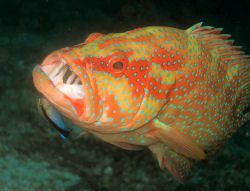 A
form of food poisoning which occurs occasionally in certain
coral reef fish. It originates in a tiny organism (dinoflagellate)
attached to algae growing usually on dead coral. A
form of food poisoning which occurs occasionally in certain
coral reef fish. It originates in a tiny organism (dinoflagellate)
attached to algae growing usually on dead coral.
It is eaten by plant-eating fish and then accumulates in large
predatory fish such as mackerel, coral trout and cod. The
tasteless and odourless toxin is not destroyed by cooking
or freezing.
All reef fish over 10kg should be treated with caution. Eat
only a little and if symptoms develop discard the fish. Avoid
internal organs of any reef fish. Symptoms, which begin 2-12
hours after fish are eaten, are varied and can include breathing
difficulty requiring artificial respiration. If symptoms develop,
induce vomiting.
Interesting Facts and figures relating
to Marine Hazards
- Box
jellyfish have been known to kill people within three minutes,
blue-ringed octopus in 30 minutes and pufferfish (eaten)
in 17 minutes.
- At
least 65 people have been killed by box jellyfish in the
last century, over 30 of them on beaches between Mackay
and Cairns.
- Aboriginal
people long knew about box jellyfish, but it was not until
after the death of a five-year-old boy at Cardwell, in 1955,
that Chironex fleckeri' was identified by scientists. The
irukandji (Carukia barnesi) was first scientifically identified
in 1961 by Cairns doctor, John Barnes. He named it after
the local Irukandji Aboriginal people.
- Toad/pufferfish
are not only poisonous to eat but can, with their beak-like
mouths, remove toes and fingers. Ancient laws worldwide
forbade consumption of these species - fish without scales
are classed as 'unclean' in the Old Testament.
- At
the base of the tails of the aptly named surgeon fish are
razor sharp blades which can inflict nasty cuts. No venom,
however, is involved.
- You
are more likely to die from a box jellyfish sting than a
shark attack. Reef sharks are not normally aggressive to
humans but should be treated with respect. Do not carry
bleeding fish and avoid swimming after dark.
|